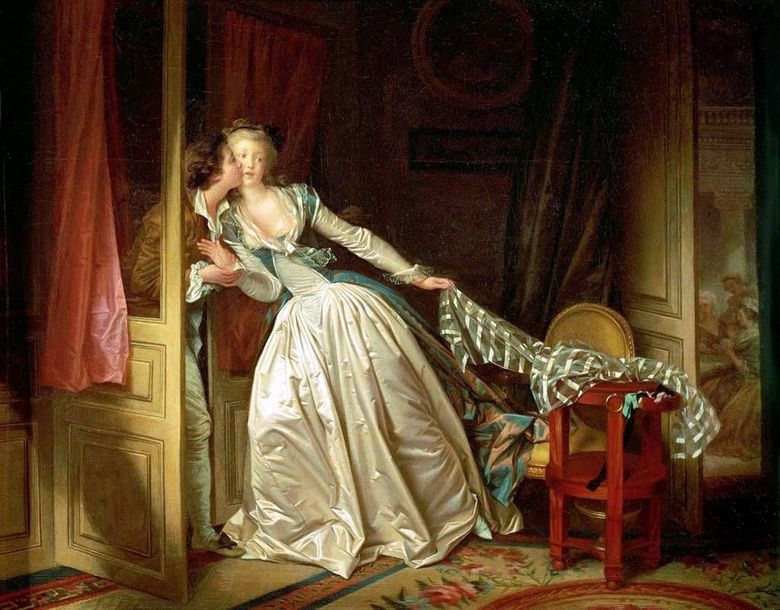
A favorite of rich customers, compelled to obey their tastes, Fragonard created “thoughtless” and elegant paintings, but remaining a son of his time, a contemporary of the Enlightenment, he consciously or intuitively responded to their demands for the democratization of art, the demand to bring it closer to life. “Kiss furtively” – one of the most characteristic works of the artist, showing how these contradictions got on in his work.
Before us is a scene, the plot of which seems to have been dictated by an aristocratic lover of painting – they are brilliant, and merry. But at the same time the scene is surprisingly truthful, as if unexpectedly seen by the artist. The girl left the living room for a minute, where the “elders” gathered to take the forgotten scarf, and instantly found herself in the embrace of the young man who was waiting for her. The whole image is full of movement and immediate feeling. Fragonard pays great attention to the transfer of a wide variety of subjects, their textures. Extremely persuasive, in Dutch, carefully and financially he writes the breaking silk of the dress, the transparent scarf, the polished surface of the working table. Love for life, for all its manifestations, large and small, appears in every stroke.
In the picture, it is not the picturesque manner characteristic of Fragonard that surprises us. This is because the artist wrote “Kiss furtively” in a relatively late creative period, in the 1780s, when the newly emerged style of classicism becomes fashionable, requiring clear lines and silhouette, great color and picturesque restraint. This style was foreign to Fragonard, although he had some influence on him. Feeling the need to update his work, the artist turned to the Dutch masters who had previously interested him. Under their influence, Fragonard wrote a number of paintings, including “The Kiss Furtively” and, apparently, a steam room for her, now lost, “The Marriage Contract.” The painting “The Kiss Furtively” entered the Hermitage in 189S from the Lazenkov Palace in Warsaw, from the collection of Stanislaw August Poniatowski;
 The Kiss Won by Jean Honoré Fragonard
The Kiss Won by Jean Honoré Fragonard Sneak a Kiss – Jean Honoré Fragonard
Sneak a Kiss – Jean Honoré Fragonard Date by Jean Honore Fragonard
Date by Jean Honore Fragonard Island of Love by Jean Honore Fragonard
Island of Love by Jean Honore Fragonard Baby swings by Jean Honore Fragonard
Baby swings by Jean Honore Fragonard The boy in the role of Piero by Jean-Honore Fragonard
The boy in the role of Piero by Jean-Honore Fragonard Education makes everything by Jean Honore Fragonard
Education makes everything by Jean Honore Fragonard Peasant children by Jean Honoré Fragonard
Peasant children by Jean Honoré Fragonard